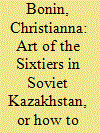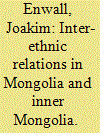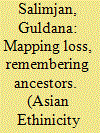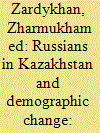| Srl | Item |
| 1 |
ID:
177710


|
|
|
|
|
| Summary/Abstract |
The artists of the Sixtiers generation in Soviet Kazakhstan have typically been understood as the creators of an authentic Kazakh style. This article demonstrates that a web of constructed vectors helped consolidate art as ‘Kazakh’ in the 1960s and early 1970s. I argue that the Sixtiers mined the history of nomadic populations in Central Asia for site-specific cultural forms as a means to connect with an expanding art world and the global context of decolonialization. Neither wholly official nor countercultural, the Sixtiers produced a cultural milieu that stretched the limits of the sayable in late Soviet socialism and defined the margins of modernity with which Kazakh artists continue to contend.
|
|
|
|
|
|
|
|
|
|
|
|
|
|
|
|
| 2 |
ID:
097813


|
|
|
|
|
| Publication |
2010.
|
| Summary/Abstract |
The article deals with the development of minority policies in Mongolia since independence from China, and focuses on the effects that these policies have had on inter-ethnic relations. The main groups studied are the Khalkha Mongols, the Kazakhs, the Tuvans and the Han Chinese. The definitions of these groups as either u ndesten or yastan have also varied over time, which has created theoretically interesting complexities. The article contains a sociolinguistic study of the inter-ethnic relations, with particular emphasis on education, culture, media and publishing. Furthermore, the tendency of the Tuvans to identify ethnically with the Mongols rather than with the Kazakhs is analyzed from the point of view of a sub-minority-majority identification theory. In Inner Mongolia, the inter-ethnic relations are problematic, and there are also severe tensions between the Mongols of Inner Mongolia and those of Mongolia. These ethnic policies have also played an important role in the development of the inter-state relations between Mongolia and the People's Republic of China.
|
|
|
|
|
|
|
|
|
|
|
|
|
|
|
|
| 3 |
ID:
177584


|
|
|
|
|
| Summary/Abstract |
Genealogical narratives are important aspects of Kazakh social life in China and the formation of self-identifications. They reflect tensions in competing forms of history-writing through which the Chinese state maintains control over its frontier. Through ethnography and critical analysis of locally produced and circulated genealogy books, this article traces the connections between genealogy as a way of knowing and its creative agency under the Chinese settler order in the Xinjiang Uyghur Autonomous Region. The article argues that Kazakh genealogy books as knowledge production are a response to Mao era assimilationist policies and reform era economic dispossession. Genealogy in this context mediates and mobilizes local histories, land epistemology, and gender ideals to construct Kazakh collective memory and belonging to ancestral places in northern Xinjiang.
|
|
|
|
|
|
|
|
|
|
|
|
|
|
|
|
| 4 |
ID:
051455


|
|
|